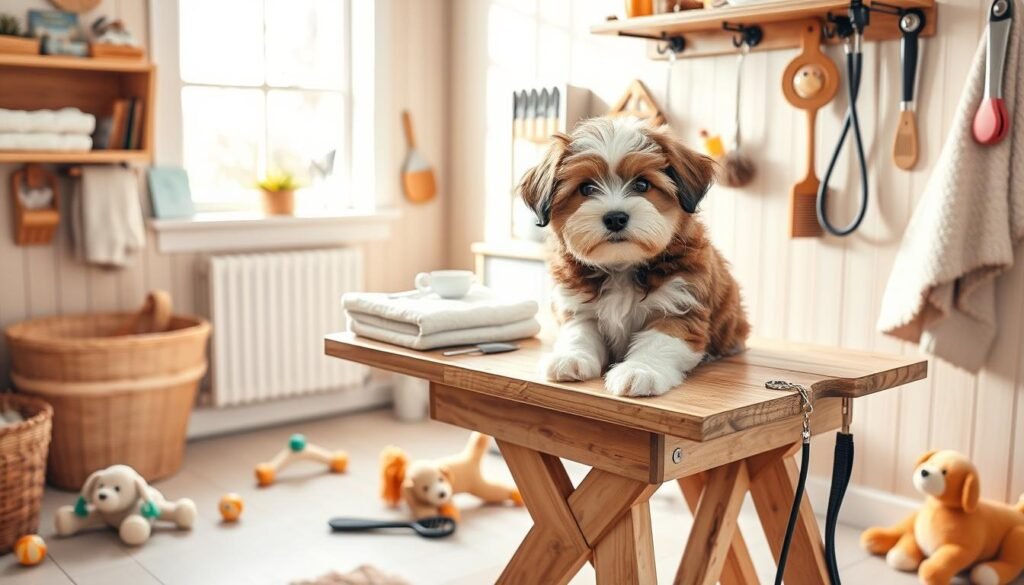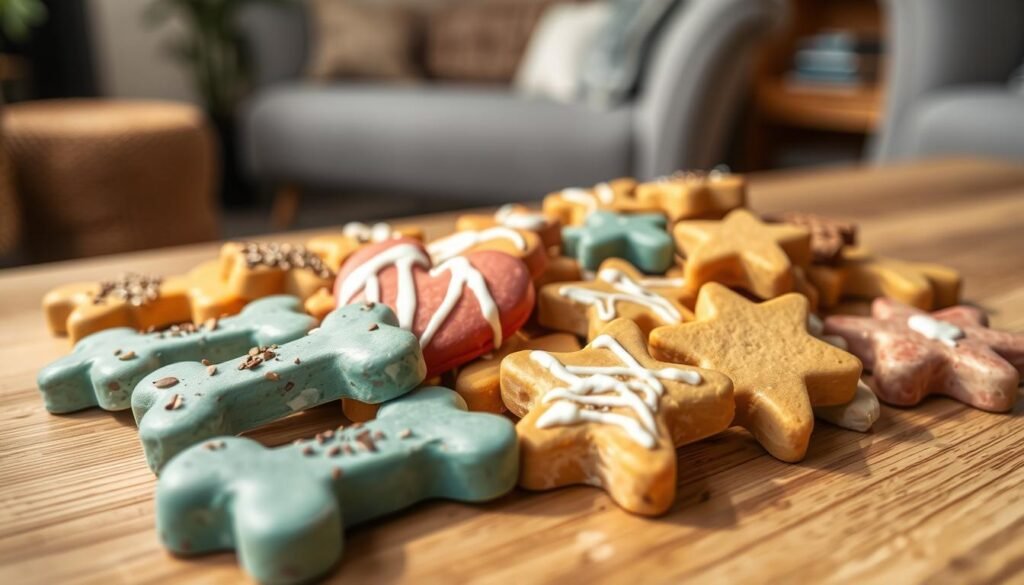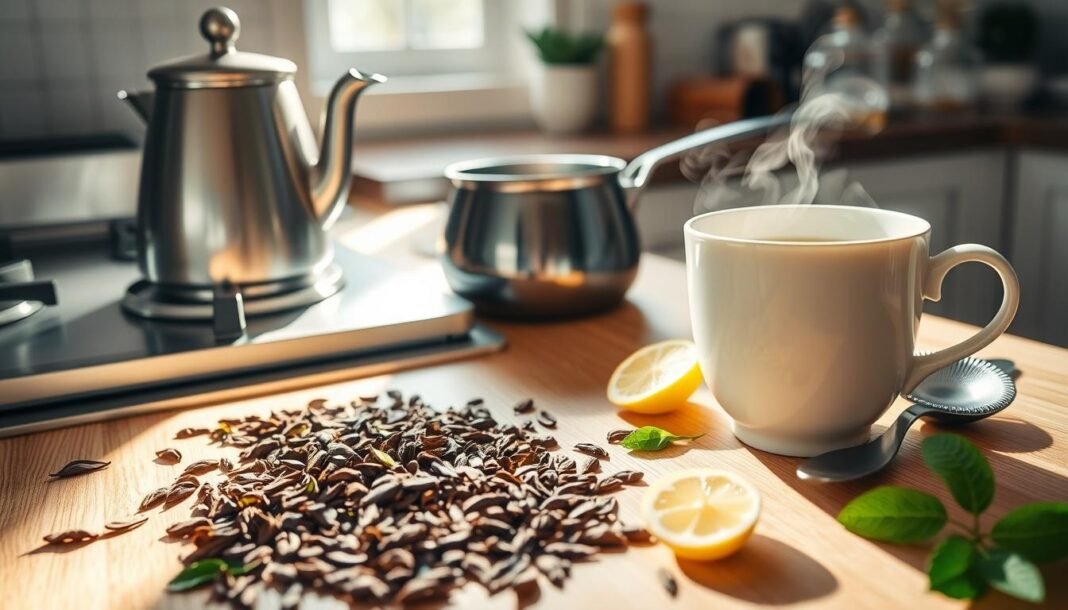Getting a new puppy is exciting and full of joy. Yet, it comes with big responsibilities. You need the right supplies to make the switch easier for you and your pup. Knowing what your new dog needs is key for their well-being and happiness.
Having the right items from the start creates a loving space. This helps your puppy grow and brings you two closer. The American Kennel Club says the right supplies make your puppy happier. They also make training easier. Let’s look at what you need for your new friend.
Key Takeaways
- Essential puppy supplies are vital for a smooth transition to pet ownership.
- Preparedness can help cater to your puppy’s health and comfort.
- Making informed choices significantly aids in training and bonding.
- The American Kennel Club emphasizes the importance of a nurturing environment.
- Understanding puppy essentials can alleviate stress for both pets and owners.
Getting Started: What You Need to Know About Puppies
Bringing a puppy home requires careful thought. It’s crucial to understand the basics for a smooth start. When looking into puppies, the breed’s specific needs are important.
Different breeds have their own characteristics and energy levels. For example, some need more exercise and mental challenges. This could change how you spend your day.
Another key point is your puppy’s early development stages. The importance of socializing your puppy cannot be overstated. By introducing them to new places, people, and pets, you’re promoting good manners.
It also helps prevent future anxiety. Starting basic obedience training early lays the groundwork for a well-mannered dog later on.
Before getting a puppy, it’s critical to plan considering your lifestyle and the dog’s needs. This planning helps smooth the transition into owning a pet. It ensures you’re prepared with the right supplies and know-how.
Puppy Essentials: A Comprehensive List
Getting a new puppy means you need to gather essential supplies. These are key to making a safe and welcoming space for your new friend. This will help your puppy feel right at home.
Food and Water Bowls
Choosing the right food and water bowls is an important first step. Go for stainless steel or ceramic since they’re tough, easy to wash, and keep germs away. Make sure they’re the right size for your puppy’s breed and age. Look for bowls with a sturdy, non-slip bottom to avoid spills during meals.
Feeding Schedule
It’s important to have a regular feeding schedule to help your puppy grow healthy. Puppies need to eat little and often because their tummies are still growing. They usually need three to four meals a day. A good feeding schedule helps them eat regularly and brings routine and comfort.
Storage Solutions for Puppy Food
Keeping puppy food fresh and nutritious is key. Use an airtight container to keep the food safe and away from pests. Store it in a cool, dry spot to keep it fresh longer. Label the container with the date you opened it to ensure your puppy always has the best quality food.
Puppy Food: Choosing the Best for Your New Companion
Choosing the right puppy food is key for your new dog’s growth. There are many types of puppy food out there. Knowing what to look for is important to ensure a healthy life for your pet. Puppies need certain nutrients to grow well, so selecting the right food is crucial.
Types of Puppy Food
There are different kinds of puppy food, each with benefits:
- Dry Kibble: It’s easy to store and usually costs less. It also helps keep teeth clean.
- Wet Food: Puppies often find it tastier. It adds water to their diet, helping with digestion.
- Raw Diets: Feeds raw meat and bones. This choice needs careful management to keep nutrition balanced.
Ingredients to Look For
Check the labels when picking puppy food. It should have high-quality protein, fats, vitamins, and minerals. These are key for growth. You should look for:
- Real Meat: Look for chicken, beef, or fish as the top ingredient.
- Whole Grains: Foods like brown rice or oatmeal provide needed energy.
- Healthy Fats: Omega fatty acids are good for skin and coat.
Consulting Your Veterinarian
Talk to your vet before choosing a puppy food. They’ll make sure it fits your pet’s specific needs. Your vet will consider your dog’s breed, age, and any special dietary needs. Stay in touch with your vet to tweak your puppy’s diet as they grow.
Puppy Toys: Keeping Your Pup Engaged
Puppy toys are very important for your new friend’s growth and happiness. They do more than just amuse; they also keep your pup’s mind and body active. Choosing the right toys encourages healthy play, social skills, and good behavior.
Different Types of Toys
There are many kinds of puppy toys to consider:
- Chew Toys: Great for puppies that are teething, these help ease gum discomfort. They also stop puppies from chewing on things they shouldn’t.
- Interactive Toys: These toys challenge your puppy’s thinking. They help with problem-solving and keep them entertained for hours.
- Plush Toys: These soft toys are comforting during sleep. They can also be fun playmates.
Choosing Safe and Durable Options
When picking toys, safety is most important. Choose toys made of safe, high-quality materials. Avoid toys with small parts that could lead to choking. Brands like Kong and Nylabone are known for their safe and durable products.
Good puppy toys make playtime fun and help bond pet and owner. There are many engaging toys out there. Finding the perfect one for your puppy’s personality is easy.
| Toy Type | Benefits | Recommended Brands |
|---|---|---|
| Chew Toys | Soothes teething, prevents chewing on furniture | Kong, Nylabone |
| Interactive Toys | Stimulates mind, encourages problem-solving | PetSafe, Outward Hound |
| Plush Toys | Provides comfort, safe for cuddling | Chuckit!, ZippyPaws |
Puppy Training Supplies: Essential Tools for Success
Getting the right tools is key to good puppy training. These supplies help teach proper behavior and set daily routines. By investing in the right tools, you and your puppy can enjoy successful training sessions.
Crates and Leashes
Crates give puppies a safe spot, helping with house training and security. Your puppy’s crate should be big enough for it to stand, turn, and lie down easily. Leashes are also crucial for teaching good walking habits and keeping your puppy safe on walks. Choose a leash that’s strong but light, and matches your puppy’s size and activity level.
Training Pads and Collars
Training pads are great for early housebreaking, guiding puppies on where to go. They should be placed in specific spots. The right collar is important, too. It needs to be tight enough to stay on but loose enough not to choke. Pick a collar made for puppies, which usually allows for size adjustment.
Helpful Training Aids
Several aids can make training your puppy more fun. Clickers offer a clear sound that marks good behavior, helping your puppy understand what you want. Treat bags are handy for carrying rewards, so you can quickly praise your puppy’s good actions. Using these tools can make training more successful and enjoyable.
| Training Tool | Purpose | Key Features |
|---|---|---|
| Crate | Provides a safe space | Portable, easy to clean, various sizes |
| Leash | Encourages good walking habits | Lightweight, durable, various lengths |
| Training Pad | Assists in house training | Absorbent, washable, disposable options |
| Collar | Holds identification and control | Adjustable, comfortable, puppy-friendly materials |
| Clicker | Signals good behavior | Audible sound, portable, easy trigger |
| Treat Bag | Stores training rewards | Hands-free, easy-access design, washable |
Puppy Grooming: Essential Products and Tips
Grooming your puppy is more than keeping them clean. It’s about comfort and building trust. A well-groomed puppy is happier and smells great. Choosing the right grooming items and learning techniques can be fun for you both.
Tools for Bathing and Brushing
Having the right tools makes grooming your puppy easy. You’ll need some key supplies:
- Shampoo: Pick a gentle shampoo made for puppies. It won’t hurt their sensitive skin.
- Brush: There are different brushes. For example, long-haired puppies might need slicker brushes, and short-haired ones, bristle brushes.
- Nail Clippers: Use clippers designed for small animals. This ensures safe and comfortable nail trimming.
- Towels: Get some absorbent towels to dry your puppy after baths.
Grooming Frequency and Techniques
How often you groom your puppy depends on their breed and coat. Long-haired breeds need grooming more often than short-haired ones. Use the right techniques for a good experience:
- Bathing: Start baths slowly with warm water. Keep the mood calm.
- Brushing: Brush gently and start with short sessions. Increase time as your puppy gets used to it.
- Daily Checks: Check their ears, eyes, and paws regularly. This helps you spot problems early.

Puppy Healthcare: Keeping Your New Friend Healthy
Keeping your puppy healthy is key for a long, joy-filled life. The early days are super important. They help set up a lifetime of health. It’s vital to take your puppy to the vet regularly and get all needed shots on time. Doing this early on catches health problems before they grow. It also keeps your puppy safe from many sicknesses. Let’s dive into what you need to know to keep your puppy thriving.
Vaccination Needs
Your puppy will need its first shots between six to eight weeks old. They should get important vaccines like:
- Canine Parvovirus
- Distemper
- Canine Adenovirus
- Rabies
Sticking to the vaccine schedule protects your puppy from big health risks as they meet other animals and explore.
Regular Vet Check-ups
Having regular vet visits is great for keeping an eye on your puppy’s health. At these check-ups, vets will:
- Monitor weight and growth
- Look for signs of sickness
- Talk about what to feed them
This is a perfect time for you to ask questions and learn more about caring for your puppy.
Preventative Medications
Preventative treatments are a big part of keeping your puppy safe. Medicines to prevent fleas, ticks, and heartworm are super important. Using these treatments will:
- Stop infestations
- Keep away diseases that pets can get from bugs
Knowing all you can about your puppy’s health will help them lead a long, active life. Always talk to your vet to get advice that fits your puppy’s needs.
| Vaccination Type | Recommended Age | Frequency |
|---|---|---|
| Canine Parvovirus | 6-8 weeks | Every 3-4 weeks until 16 weeks |
| Distemper | 6-8 weeks | Every 3-4 weeks until 16 weeks |
| Canine Adenovirus | 6-8 weeks | Every 3-4 weeks until 16 weeks |
| Rabies | 12-16 weeks | Yearly thereafter |
Puppy Beds: Creating a Comfort Zone
Making a cozy sleeping spot for your puppy is key to their happiness. The right puppy bed offers comfort and supports their body. When picking dog beds, think about what will make your pet’s sleep better.
Choosing the Right Size and Style
Finding the right size and style of bed is important for your puppy’s comfort. Consider these tips:
- Look at your puppy’s breed and size for bed size.
- Think about if they like curling up or sprawling out.
- Choose beds with covers you can wash easily.
Benefits of a Comfortable Bed
Quality puppy beds bring many benefits. They help your puppy sleep well and stay healthy.
- Better sleep means more energy and nicer behavior.
- Supportive beds protect growing joints.
- A personal bed teaches good habits and boundaries.
Furhaven and PetFusion have great bed options. They ensure you get a good bed for your pet.
| Brand | Bed Type | Size Options | Key Features |
|---|---|---|---|
| Furhaven | Orthopedic Sofa Bed | Small, Medium, Large | Cooling foam, removable cover |
| PetFusion | Memory Foam Bed | Medium, Large, XL | Water-resistant liner, non-skid bottom |
Puppy Treats: Rewarding Good Behavior
Puppy treats help a lot in training and showing love. They’re not just tasty rewards. They also make puppies and owners form a happy bond. It’s key to know what treats are out there and choose the healthy ones.
Types of Treats to Consider
Think about these puppy treat options:
- Soft Chews: They’re easy for puppies to chew and digest.
- Crunchy Biscuits: These are good for teeth and satisfy the need to chew.
- Training-Specific Options: Small, low-cal treats perfect for quick training rewards.
Healthy Treat Options
It’s important to pick treats that are good for your puppy’s health. Choose brands like Zuke’s and Blue Buffalo for quality. Some good choices are:
- Grain-free treats for puppies with allergies.
- Natural ingredient treats, like fruits and veggies.
- Low-fat but tasty options.
How to Use Treats in Training
When training with treats, it’s best to keep a few things in mind. Here are some tips:
- Reward right after your puppy does what you want.
- Mix up the treats to keep training fun and interesting.
- Start to give fewer treats for simple things as your puppy learns them.

Conclusion
Getting a new puppy is exciting. You’ll need the right things to make your home welcoming. A good checklist is key. It has everything you need, from food to toys. Each item helps your puppy feel loved.
Being prepared is vital for a happy puppy. Keep your checklist updated. This way, you’re ready for puppy challenges and joys. Having a puppy is a long journey. It’s full of learning and memorable moments.
Good pet owners always aim to provide the best for their puppies. Enjoy every moment with your new friend. The bond you create is one-of-a-kind.


